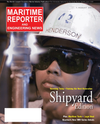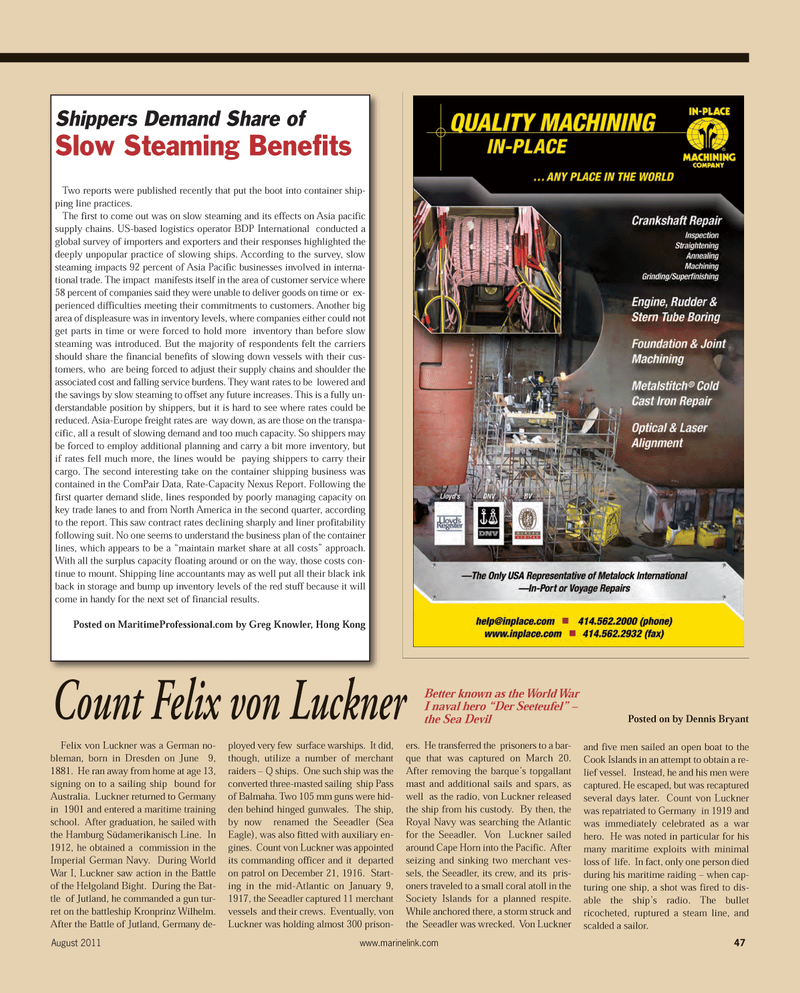
Page 47: of Maritime Reporter Magazine (August 2011)
Top 20 Shipyards of the World
Read this page in Pdf, Flash or Html5 edition of August 2011 Maritime Reporter Magazine
Felix von Luckner was a German no- bleman, born in Dresden on June 9,1881. He ran away from home at age 13, signing on to a sailing ship bound forAustralia. Luckner returned to Germany in 1901 and entered a maritime trainingschool. After graduation, he sailed with the Hamburg Südamerikanisch Line. In 1912, he obtained a commission in theImperial German Navy. During World War I, Luckner saw action in the Battle of the Helgoland Bight. During the Bat-tle of Jutland, he commanded a gun tur- ret on the battleship Kronprinz Wilhelm. After the Battle of Jutland, Germany de- ployed very few surface warships. It did, though, utilize a number of merchantraiders ? Q ships. One such ship was the converted three-masted sailing ship Pass of Balmaha. Two 105 mm guns were hid- den behind hinged gunwales. The ship, by now renamed the Seeadler (Sea Eagle), was also fitted with auxiliary en- gines. Count von Luckner was appointed its commanding officer and it departed on patrol on December 21, 1916. Start-ing in the mid-Atlantic on January 9,1917, the Seeadler captured 11 merchantvessels and their crews. Eventually, von Luckner was holding almost 300 prison- ers. He transferred the prisoners to a bar- que that was captured on March 20. After removing the barque?s topgallant mast and additional sails and spars, aswell as the radio, von Luckner released the ship from his custody. By then, the Royal Navy was searching the Atlantic for the Seeadler. Von Luckner sailed around Cape Horn into the Pacific. After seizing and sinking two merchant ves- sels, the Seeadler, its crew, and its pris- oners traveled to a small coral atoll in the Society Islands for a planned respite.While anchored there, a storm struck andthe Seeadler was wrecked. Von Luckner and five men sailed an open boat to the Cook Islands in an attempt to obtain a re-lief vessel. Instead, he and his men were captured. He escaped, but was recaptured several days later. Count von Luckner was repatriated to Germany in 1919 and was immediately celebrated as a war hero. He was noted in particular for his many maritime exploits with minimal loss of life. In fact, only one person died during his maritime raiding ? when cap-turing one ship, a shot was fired to dis- able the ship?s radio. The bullet ricocheted, ruptured a steam line, andscalded a sailor. August 2011www.marinelink.com 47Shippers Demand Share of Slow Steaming BenefitsTwo reports were published recently that put the boot into container ship- ping line practices.The first to come out was on slow steaming and its effects on Asia pacific supply chains. US-based logistics operator BDP International conducted aglobal survey of importers and exporters and their responses highlighted the deeply unpopular practice of slowing ships. According to the survey, slow steaming impacts 92 percent of Asia Pacific businesses involved in interna- tional trade. The impact manifests itself in the area of customer service where 58 percent of companies said they were unable to deliver goods on time or ex- perienced difficulties meeting their commitments to customers. Another big area of displeasure was in inventory levels, where companies either could not get parts in time or were forced to hold more inventory than before slow steaming was introduced. But the majority of respondents felt the carriers should share the financial benefits of slowing down vessels with their cus- tomers, who are being forced to adjust their supply chains and shoulder theassociated cost and falling service burdens. They want rates to be lowered and the savings by slow steaming to offset any future increases. This is a fully un- derstandable position by shippers, but it is hard to see where rates could be reduced. Asia-Europe freight rates are way down, as are those on the transpa- cific, all a result of slowing demand and too much capacity. So shippers may be forced to employ additional planning and carry a bit more inventory, but if rates fell much more, the lines would be paying shippers to carry their cargo. The second interesting take on the container shipping business was contained in the ComPair Data, Rate-Capacity Nexus Report. Following the first quarter demand slide, lines responded by poorly managing capacity on key trade lanes to and from North America in the second quarter, according to the report. This saw contract rates declining sharply and liner profitability following suit. No one seems to understand the business plan of the container lines, which appears to be a ?maintain market share at all costs? approach. With all the surplus capacity floating around or on the way, those costs con- tinue to mount. Shipping line accountants may as well put all their black inkback in storage and bump up inventory levels of the red stuff because it will come in handy for the next set of financial results. Posted on MaritimeProfessional.com by Greg Knowler, Hong Kong Count Felix von Luckner Better known as the World War I naval hero ?Der Seeteufel? ? the Sea Devil Posted on by Dennis Bryant MR Aug. 11 # 6 (42-49):MR Template 8/5/2011 9:55 AM Page 47

 46
46

 48
48
